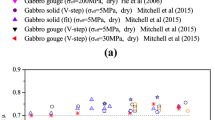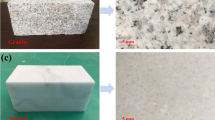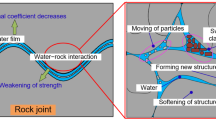Abstract
There is a growing demand of knowledge on the behavior of rock masses after thermal treatment in both academic and practical aspects due to the high demand of construction of underground structures under the high-temperature environment. The peak shear strength of rock joints has a significant role in evaluating the stability problems of surrounding rocks. However, there is a lack of information about the temperature-dependent nature of the basic friction angle of rock joints, which serves as an essential parameter to evaluate the peak shear strength. The present study experimentally investigates the influences of temperature magnitude (20, 200, 400, 600, and 800 °C) on the basic friction angle of granite, marble, and red sandstone joints. The basic friction angles of the three kinds of rock joints exhibit linear trends with the increase in the treatment temperature. The basic friction angles of granite and red sandstone joints increase with the increase in the treatment temperature, while the values for marble joints continually decrease. The mechanisms for the thermally altered variations in the basic friction angle of rock joint are mainly related to dehydration process, uneven expansion of mineral grains, thermally weakened asperities distributed on the surfaces, and change in physical and mechanical properties of minerals. In addition, other test conditions, including tilting rate, specimen size, repetition number, and cooling rate, are also analyzed. The present study provides useful data in establishing a peak shear strength criterion for rock joints by considering the temperature effect.












Similar content being viewed by others
References
Alejano LR, González J, Muralha J (2012) Comparison of different techniques of tilt testing and basic friction angle variability assessment. Rock Mech Rock Eng 45:1023–1035
Alejano LR, Muralha J, Ulusay R, Li CC, Pérez-Rey I, Karakul H, Chryssanthakis P, Aydan Ö, Martínez J, Zhang N (2017) A benchmark experiment to assess factors affecting tilt test results for sawcut rock surfaces. Rock Mech Rock Eng 50:2547–2562
Alejano LR, Muralha J, Ulusay R, Li CC, Pérez-Rey I, Karakul H, Chryssanthakis P, Aydan Ö (2018) ISRM suggested method for determining the basic friction angle of planar rock surfaces by means of tilt tests. Rock Mech Rock Eng 51:3853–3859
Barton N (1973) Review of a new shear-strength criterion for rock joints. Eng Geol 7:287–332
Barton N (1976) The shear strength of rock and rock joints. Int J Rock Mech Min Sci Geomech Abstr 13:255–279
Barton N (2013) Shear strength criteria for rock, rock joints, rockfill and rock masses: problems and some solutions. J Rock Mech Geotech Eng 5:249–261
Barton N, Choubey V (1977) The shear strength of rock joints in theory and practice. Rock Mech Rock Eng 10:1–54
Bruce IG, Cruden DM, Eaton TM (1989) Use of a tilting table to determine the basic friction angle of hard rock samples. Can Geotech J 26:474–479
Cruden DM, Hu XQ (1988) Basic friction angles of carbonate rocks from Kananaskis country, Canada. Bull Int Assoc Eng Geol 38:55–59
Farrar NS, Cawsey DC (1976) Discussion: a simple sliding apparatus for the measurement of rock joint friction. Géotechnique 26:382–386
González J, González-Pastoriza N, Castro U, Alejano LR, Muralha J (2014) Considerations on the laboratory estimate of the basic friction angle of rock joints. In: Rock engineering and rock mechanics: structures in and on rock masses—proceedings of EUROCK 2014, ISRM European Regional Symposium, pp 199–204
Grasselli G (2006) Manuel Rocha Medal Recipient Shear Strength of rock joints based on quantified surface description. Rock Mech Rock Eng 39:295
Hencher SR (1977) The effect of vibration on the friction between planar rock surfaces, Ph.D. Imperial College of Science and Technology, London
Hencher SR (1995) Interpretation of direct shear tests on rock joints
Hencher SR (2012) Discussion of Alejano, Gonzalez and Muralha (2012). Rock Mech Rock Eng 45:1137–1139
Hencher SR, Richards LR (1989) Laboratory direct shear testing of rock discontinuities. Ground Eng 22:24–31
Hu XQ, Cruden DM (1992) A portable tilting table for on-site tests of the friction angles of discontinuities in rock masses. Bull Int Assoc Eng Geol 46:59–62
Jang HS, Zhang QZ, Kang SS, Jang BA (2017) Determination of the basic friction angle of rock surfaces by tilt tests. Rock Mech Rock Eng 51:989–1004
Khamrat S, Thongprapha T, Fuenkajorn K (2018) Thermal effects on shearing resistance of fractures in Tak granite. J Struct Geol 111:64–74
Kim T, Jeon S (2019) Experimental study on shear behavior of a rock discontinuity under various thermal, hydraulic and mechanical conditions. Rock Mech Rock Eng. https://doi.org/10.1007/s00603-018-1723-7
Kulatilake PHSW, Shou G, Huang TH, Morgan RM (1995) New peak shear strength criteria for anisotropic rock joints. Int J Rock Mech Min Sci Geomech Abstr 32:673–697
Kumari WGP, Ranjith PG, Perera MSA, Chen BK, Abdulagatov IM (2017) Temperature-dependent mechanical behaviour of Australian Strathbogie granite with different cooling treatments. Eng Geol 229:31–44
Li CC, Zhang N, Ruiz J (2019) Measurement of the basic friction angle of planar rock discontinuities with three rock cores. Bull Eng Geol Environ 78:847–856
Lomenick TF, Bradshaw RL (1969) Deformation of rock salt in openings mined for the disposal of radioactive wastes. Rock Mech 1:5–29
Olsson WA (1974) Effects of temperature, pressure and displacement rate on the frictional characteristics of a limestone. Int J Rock Mech Min Sci Geomech Abstr 11:267–278
Park J-W, Park D, Ryu D-W, Choi B-H, Park E-S (2014) Analysis on heat transfer and heat loss characteristics of rock cavern thermal energy storage. Eng Geol 181:142–156
Patton FD (1966) Multiple modes of shear failure in rock 1st ISRM Congress. International Society for Rock Mechanics and Rock Engineering, Lisbon
Peng J, Rong G, Cai M, Yao M-D, Zhou C-B (2016) Physical and mechanical behaviors of a thermal-damaged coarse marble under uniaxial compression. Eng Geol 200:88–93
Pérez-Rey I, Alejano LR, González-Pastoriza N, González J, Arzúa J (2015) Effect of time and wear on the basic friction angle of rock discontinuities. In: ISRM European regional symposium: Eurock 2015 and geomechanics colloquium
Pérez-Rey I, Alejano LR, Arzúa J, Muralha J (2016) The role of tilting rate and wear of surfaces on basic friction angle testing ISRM international symposium—EUROCK 2016. International Society for Rock Mechanics and Rock Engineering, Ürgüp, p 6
Ruiz J, Li C (2014) Measurement of the basic friction angle of rock by three different tilt test methods. Taylor and Francis, London
Shao S, Ranjith PG, Wasantha PLP, Chen BK (2015) Experimental and numerical studies on the mechanical behaviour of Australian Strathbogie granite at high temperatures: an application to geothermal energy. Geothermics 54:96–108
Stimpson B (1981) A suggested technique for determining the basic friction angle of rock surfaces using core. Int J Rock Mech Min Sci Geomech Abstr 18:63–65
Sun Q, Lü C, Cao L, Li W, Geng J, Zhang W (2016) Thermal properties of sandstone after treatment at high temperature. Int J Rock Mech Min Sci 85:60–66
Tang ZC, Wong LNY (2016) New criterion for evaluating the peak shear strength of rock joints under different contact states. Rock Mech Rock Eng 49:1191–1199
Tang ZC, Sun M, Peng J (2019) Influence of high temperature duration on physical, thermal and mechanical properties of a fine-grained marble. Appl Therm Eng 156:34–50
Tian H, Ziegler M, Kempka T (2014) Physical and mechanical behavior of claystone exposed to temperatures up to 1000 °C. Int J Rock Mech Min Sci 70:144–153
Tian H, Mei G, Jiang GS, Qin Y (2017) High-temperature influence on mechanical properties of diorite. Rock Mech Rock Eng 50:1661–1666
Ulusay R, Karakul H (2016) Assessment of basic friction angles of various rock types from Turkey under dry, wet and submerged conditions and some considerations on tilt testing. Bull Eng Geol Environ 75:1683–1699
Wines DR, Lilly PA (2003) Estimates of rock joint shear strength in part of the Fimiston open pit operation in Western Australia. Int J Rock Mech Min Sci 40:929–937
Xia CC, Tang ZC, Xiao WM, Song YL (2014) New peak shear strength criterion of rock joints based on quantified surface description. Rock Mech Rock Eng 47:387–400
Yang S-Q, Xu P, Li Y-B, Huang Y-H (2017) Experimental investigation on triaxial mechanical and permeability behavior of sandstone after exposure to different high temperature treatments. Geothermics 69:93–109
Zhang W, Sun Q, Hao S, Geng J, Chao L (2016) Experimental study on the variation of physical and mechanical properties of rock after high temperature treatment. Appl Therm Eng 98:1297–1304
Zhang W, Sun Q, Zhu S, Bo W (2017a) Experimental study on mechanical and porous characteristics of limestone affected by high temperature. Appl Therm Eng 110:356–362
Zhang Y, Sun Q, Cao L, Geng J (2017b) Pore, mechanics and acoustic emission characteristics of limestone under the influence of temperature. Appl Therm Eng 123:1237–1244
Zhang Y, Sun Q, He H, Cao L, Zhang W, Bo W (2017c) Pore characteristics and mechanical properties of sandstone under the influence of temperature. Appl Therm Eng 113:537–543
Zhang F, Zhao J, Hu D, Skoczylas F, Shao J (2018) Laboratory investigation on physical and mechanical properties of granite after heating and water-cooling treatment. Rock Mech Rock Eng 51:677–694
Zhao J (1997) Joint surface matching and shear strength part B: JRC-JMC shear strength criterion. Int J Rock Mech Min Sci 34:179–185
Zhao Z, Dou Z, Xu H, Liu Z (2019) Shear behavior of Beishan granite fractures after thermal treatment. Eng Fract Mech 213:223–240
Zhou SW, Xia CC, Du SG, Zhang PY, Zhou Y (2015) An analytical solution for mechanical responses induced by temperature and air pressure in a lined rock cavern for underground compressed air energy storage. Rock Mech Rock Eng 48:749–770
Zhu S, Zhang W, Sun Q, Deng S, Geng J, Li C (2017) Thermally induced variation of primary wave velocity in granite from Yantai: experimental and modeling results. Int J Therm Sci 114:320–326
Acknowledgements
The authors gratefully acknowledge the support from the Natural Science Foundation of China (Grant nos. 41672302, 51578408, 41731284, and 51609178) and the Fundamental Research Funds for the Central Universities, China University of Geosciences (Wuhan) (Grant no. CUG170603). Many thinks are also given to Yu Tang, Yu Feng Zhang, and Yong Yi Li for their assistance in performing the tilt tests.
Author information
Authors and Affiliations
Corresponding author
Ethics declarations
Conflict of interest
The authors declare that they have no conflicts of interest.
Additional information
Publisher's Note
Springer Nature remains neutral with regard to jurisdictional claims in published maps and institutional affiliations.
Rights and permissions
About this article
Cite this article
Tang, Z.C., Zhang, Q.Z. & Peng, J. Effect of Thermal Treatment on the Basic Friction Angle of Rock Joint. Rock Mech Rock Eng 53, 1973–1990 (2020). https://doi.org/10.1007/s00603-019-02026-w
Received:
Accepted:
Published:
Issue Date:
DOI: https://doi.org/10.1007/s00603-019-02026-w




